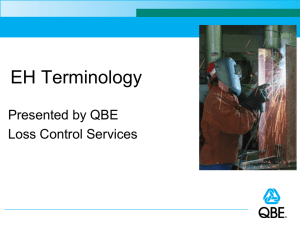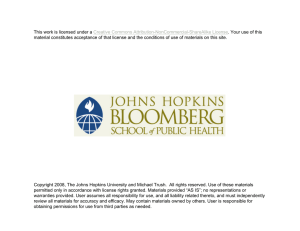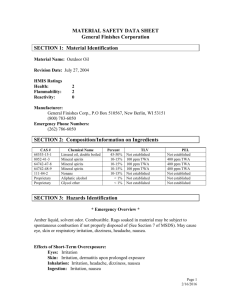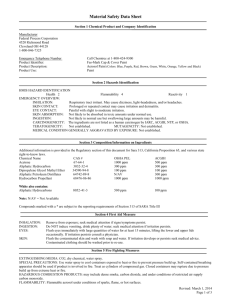safety data sheet
advertisement
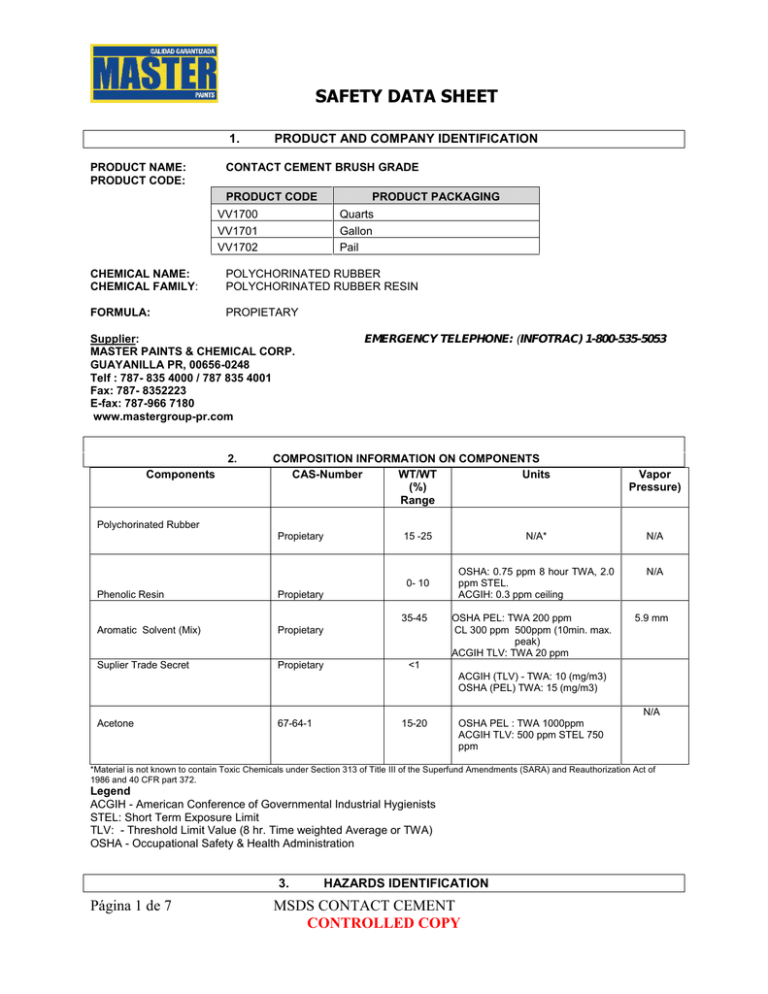
SAFETY DATA SHEET 1. PRODUCT NAME: PRODUCT CODE: PRODUCT AND COMPANY IDENTIFICATION CONTACT CEMENT BRUSH GRADE PRODUCT CODE VV1700 VV1701 VV1702 PRODUCT PACKAGING Quarts Gallon Pail CHEMICAL NAME: CHEMICAL FAMILY: POLYCHORINATED RUBBER POLYCHORINATED RUBBER RESIN FORMULA: PROPIETARY Supplier: MASTER PAINTS & CHEMICAL CORP. GUAYANILLA PR, 00656-0248 Telf : 787- 835 4000 / 787 835 4001 Fax: 787- 8352223 E-fax: 787-966 7180 www.mastergroup-pr.com 2. Components EMERGENCY TELEPHONE: (INFOTRAC) 1-800-535-5053 COMPOSITION INFORMATION ON COMPONENTS CAS-Number WT/WT Units (%) Range Vapor Pressure) Polychorinated Rubber Propietary Phenolic Resin Propietary Aromatic Solvent (Mix) Propietary Suplier Trade Secret Propietary 15 -25 N/A* N/A OSHA: 0.75 ppm 8 hour TWA, 2.0 ppm STEL. ACGIH: 0.3 ppm ceiling N/A 0- 10 35-45 OSHA PEL: TWA 200 ppm CL 300 ppm 500ppm (10min. max. peak) ACGIH TLV: TWA 20 ppm 5.9 mm <1 ACGIH (TLV) - TWA: 10 (mg/m3) OSHA (PEL) TWA: 15 (mg/m3) N/A Acetone 67-64-1 15-20 OSHA PEL : TWA 1000ppm ACGIH TLV: 500 ppm STEL 750 ppm *Material is not known to contain Toxic Chemicals under Section 313 of Title III of the Superfund Amendments (SARA) and Reauthorization Act of 1986 and 40 CFR part 372. Legend ACGIH - American Conference of Governmental Industrial Hygienists STEL: Short Term Exposure Limit TLV: - Threshold Limit Value (8 hr. Time weighted Average or TWA) OSHA - Occupational Safety & Health Administration 3. Página 1 de 7 HAZARDS IDENTIFICATION MSDS CONTACT CEMENT CONTROLLED COPY SAFETY DATA SHEET GHS Label elements, including precautionary statements Emergency Overview Signal word Danger Hazard Statements Causes skin irritation Causes serious eye irritation May cause drowsiness or dizziness Suspected of damaging fertility or the unborn child May cause damage to organs through prolonged or repeated exposure Highly flammable liquid and vapor Appearance Clear, colorless to Physical State Liquid yellow/orange Precautionary Statements - Prevention Obtain special instructions before use Do not handle until all safety precautions have been read and understood Use personal protective equipment as required Wash face, hands and any exposed skin thoroughly after handling Use only outdoors or in a well-ventilated area Do not breathe dust/fume/gas/mist/vapors/spray Keep away from heat/sparks/open flames/hot surfaces. - No smoking Keep container tightly closed Ground/bond container and receiving equipment Use explosion-proof electrical/ ventilating/ lighting/ equipment Use only non-sparking tools Take precautionary measures against static discharge Keep cool Wear eye/face protection Odor Aromatic solvent/toluene Precautionary Statements - Response IF exposed or concerned: Get medical advice/attention Specific treatment (see supplemental first aid instructions on this label) Eyes IF IN EYES: Rinse cautiously with water for several minutes. Remove contact lenses, if present and easy to do. Continue rinsing If eye irritation persists: Get medical advice/attention Skin IF ON SKIN (or hair): Remove/Take off immediately all contaminated clothing. Rinse skin with water/shower If skin irritation occurs: Get medical advice/attention Wash contaminated clothing before reuse Inhalation IF INHALED: Remove victim to fresh air and keep at rest in a position comfortable for breathing Fire In case of fire: Use CO2, dry chemical, or foam for extinction Página 2 de 7 MSDS CONTACT CEMENT CONTROLLED COPY SAFETY DATA SHEET 4. FIRST AID MEASURES Inhalation: Remove patient to fresh air. If patient is having difficulty breathing, seek immediate medical attention. If not breathing, clear airway and start mouth-to-mouth artificial respiration (or use bag-mask respirator). Seek immediate medical attention. Skin Contact: Wash affected areas with soap and water. If irritation develops, seek medical attention. If product is absorbed into clothing, remove clothing as soon as possible. Launder clothing before reusing. Eye Contact: Flush eyes with water for 15 minutes. Remove contact lenses prior to water flush. Seek medical attention. Ingestion: Give patient 3-4 glasses of water. DO NOT induce vomiting. Seek immediate medical attention. DO NOT give anything by mouth to an unconscious person. Ingestion may cause irritation to the gastro-intestinal tract. Additional Information: Sudden death due to ventricular fibrillation has been reported from acute inhalation in chronic solvent abusers. Life support should be provided due to CNS depression, cardiopulmonary failure, and Metabolic acidosis in massive overexposure. 5. FIRE-FIGHTING MEASURES Flash Point: -5ºF (23 ºF) / Seta Flash Closed Cup Burning Rate: Not Available Flammability Classification: Flammable liquid Firefighting Equipment: Use self-contained breathing apparatus with full-face piece and pressure demand or other positive-pressure mode. Risk of explosion due to mechanical impact: Not Available Risk of explosion due to static discharge: Static discharge may serve as an ignition source for this product. Hazardous Products of Combustion: Carbon Oxides (CO and CO2) and various Hydrocarbons. Special Remarks: Extremely flammable liquid and vapor. Vapor may cause flash fires. Vapors are heavier than air and can travel long distances to ignition sources. For small or incipient fire, use dry chemical, CO2, or alcohol foam. For large fire, use alcohol foam, water spray or fog. Cool containing vessels with water jet to prevent pressure build-up, autoignition, or explosion. All electrical equipment in area must be rated for flammable liquids. Bond and ground all containers when dispensing. 6. ACCIDENTAL RELEASE MEASURES Personal Precautions: Wear appropiate PPE. Extremely flammable. Remove all sources of ignition. Make sure area is well ventilated. Spilled adhesive may be slippery Environmental Precautions: Prevent further leakage or spillage if safe to do so. Prevent product from entering drains. Do not flush into surface water or sanitary sewer system. Small Spill or Leak: Absorb spilled product with vermiculite, dry sand, or earth. Place in a suitable non-leaking container and tightly seal for disposal. Large Spill or Leak: Dike and contain spill. Absorb spilled product with vermiculite, dry sand, or earth. Place in a suitable non-leaking container and tightly seal for disposal. Página 3 de 7 MSDS CONTACT CEMENT CONTROLLED COPY SAFETY DATA SHEET 7. HANDLING AND STORAGE Handling Precautions: Wear appropriate PPE. Keep away from heat, sparks, and flames. If used indoors, make sure to provide adequate ventilation to prevent vapor build-up. Bond and ground all containers when dispensing. All electrical equipment in area must be rated for flammable liquids. Storage Requirements: Flammable material should be stored away form other materials in a storage cabinet or room. Store in a cool, dry, well-ventilated area. Ensure product is kept away from all sources of heat and sparks. Keep container tightly closed when not in use. Prohibit smoking in the storage area. Do not store with acids or oxidizers. 8. EXPOSURE CONTROLS / PERSONAL PROTECTION Engineering Controls: Provide exhaust ventilation or other engineering controls to keep airborne concentrations of vapors below their respective threshold limit value. Ensure that a working eyewash and safety shower are in the work area. Protective Equipment: Wear splash goggles or safety glasses with side shields, synthetic apron, and neoprene or rubber gloves. In case of insufficient ventilation, wear an approved (NIOSH) respirator with organic vapor cartridge and dust/mist pre-filter. Exposure Guidelines/Other: Product Name Exposure Limits n-Hexane OSHA PEL: TWA 500ppm ACGIH TLV: TWA 50 ppm Toluene OSHA PEL: TWA 200ppm. CEL 300 ppm. ACGIH TLV: TWA 20 ppm Acetone: OSHA PEL: TWA 1000 ppm ACGIH TLV: TWA 500 ppm STEL 750 ppm Consult local authorities and local regulations for exposure limits. 9. PHYSICAL AND CHEMICAL PROPERTIES Appearance: Clear Red Liquid Odor: Strong Solvent PH: Not Applicable Specific Gravity / Density: 0.89 / 7.4 lbs./ gal Volatile by weight (max): 80 % Non Volatile Component by weight (min): 20 % Vapor Pressure: Vapor Density: Evaporation Rate VOC Content: 602.5g/L Boiling Point: (176 -185)ºF / (80-85)ºC Flash Point: -5ºF (23 ºF ) / Seta Flash Closed Cup Viscosity: (700 – 1800) cps Solubility: Not Soluble in Water 185 mm Hg @ 20ºC Highest component value is 3.14 for Toluene (air = 1) Weighted average is 2.65 (air = 1) Highest component value is 7.7 for Acetone Weighted average is 6.1compared to Butyl Acetate 10. Chemical Stability: 500ppm (10 min. max. peak) STABILITY AND REACTIVITY Product is stable as supplied. Conditions To Avoid: All ignition sources and elevated temperatures. Incompatible Materials: Cooper and Cooper alloys, strong acids, alkalies, reducing agents, and oxidizers Hazardous Decomposition Products: Carbon dioxide (CO and CO2) and Hydrocarbons. Possibility Of Hazardous Polymerization: Will not occur by itself. Página 4 de 7 MSDS CONTACT CEMENT CONTROLLED COPY SAFETY DATA SHEET 11. Acute Toxicity to Animals: Acetone: n-Hexane: Toluene: TOXICOLOGICAL INFORMATION Inhalation 4 hour LC50=30000ppm (rat) Inhalation 4 hour LC50=18600ppm (mouse) Oral LD50=5800 mg/kg (rat) Dermal LD50>16000 mg/kg (rat) Inhalation 4 hour LC50=38500 ppm (rat) Oral LD50: 28700 mg/kg (rat) Inhalation 4 hour LC50=7585 (rat) Inhalation 4 hour LC50=7100 ppm (mouse) Oral LD50=5580 mg/kg (male rat) Dermal LD50=12125 mg/kg (rabbit) Chronic Toxicity to Animals: No additional information Acute Toxicity to Humans: No additional information Chronic Effects on Humans: Classified PROVEN for human (n-Hexane). n-Hexane has been shown to cause neuropathy (numbness of arms and legs) in long term exposures . Carcinogenic Effects: Not classifiable for humans or animals. Mutagenic Effects: Classified NONE for human. Teratogenic Effects: Classified PROVEN for human (Toluene). Developmental Toxicity: Classified PROVEN for human (Toluene). Causes damage to kidneys, liver, and central nervous system. Has been reported to cause spontaneous abortion in woman that intentionally concentrated and inhaled vapors. 12. ECOLOGICAL INFORMATION Ecotoxicity: Product may kill grasses and small plants. Non-toxic to fish. Moderately toxic to amphibians by preventing dermal respiration. may cause gastrointestinal distress to birds and mammals by ingestion. BOD5 and COD: Not Available. Biodegradable/OECD: Not Available Mobility: Not Available Toxicity of the Products of Biodegradation: Not Available Special Remarks on the Products of Biodegradation: Not Available 13. DISPOSAL CONSIDERATIONS Spilled, contaminated, or waste material should be put into a suitable container and handled according to Federal, State, and local regulations. Contact a qualified waste management company for assistance. Do not incinerate, weld, cut or braze container. Residual vapors may be explosive. Empty containers should be disposed of properly. Dispose of in accordance with Federal, State and Local regulations. Página 5 de 7 MSDS CONTACT CEMENT CONTROLLED COPY SAFETY DATA SHEET 14. TRANSPORT INFORMATION Multi-modal shipping descriptions are provides for informational purpose and do not consider container sizes. The presence of a shipping description for a particular mode of transport (ocean, air, etc.), does not indicate that the product is packaged suitable for that model of transport. All packaging must be reviewed for suitability prior to shipment, and compliance with the applicable regulations is the sole responsibility of the person offering the product for transport. DOT 5 Liter (1.3 Gallons) and Less may be Classed as LTD. QTY. Larger Containers are Regulated as: UN1133, ADHESIVES, CONTAINING FLAMMABLE LIQUID, 3, PG II, (ERG#128) Proper Shipping Name Hazard Class Packing Group Marine Pollutant ERG Number ADHESIVES, CONTAINING FLAMMABLE LIQUID 3 II This product do not contains a chemical which is listed as a marine pollutant according to DOT 128 TDG UN-No. Proper Shipping Name Hazard Class Packing Group Description UN1133 ADHESIVES 3 II N1133, ADHESIVES, 3, II MEX UN-No. Proper Shipping Name Hazard Class Packing Group Description UN1133 ADHESIVES 3 II UN1133, ADHESIVES, 3, II ICAO UN-No. Proper Shipping Name Hazard Class Packing Group Description UN1133 ADHESIVES 3 II UN1133, ADHESIVES, 3, II IATA UN-No. Proper Shipping Name Hazard Class Packing Group Description UN1133 ADHESIVES 3 II UN1133, ADHESIVES, 3, II IMDG/IMO UN-No. Proper Shipping Name Hazard Class Packing Group EmS-No. Description UN1133 ADHESIVES 3 II F-E, S-D UN1133, ADHESIVES, 3, II, (-5°C C.C.) Página 6 de 7 MSDS CONTACT CEMENT CONTROLLED COPY SAFETY DATA SHEET 15. REGULATORY INFORMATION U.S. Federal Regulations Chemical (& CAS Number) SARA 302 (EHS)TPQ SARA 304 (EHS) Rq Acetone (67-64-1) n-Hexane (110-54-3) Toluene (108-88-3) All quantities in pounds SARA 313 de minimis 1 1 CERCLA Rq 5000 5000 1000 CAA 112(r) TQ RCRA code U002 U220 TSCA Inventory Status: All components of this material are listed on the US Toxic Substances Control Act (TSCA) inventory. International Regulations: Canadian Inventory Status: All components of this material are listed on the Canadian Domestic Substances List (DSL). EINECS: The chemical in this product are listed. WHIMS: B2 & D2B\ 16. DISCLAIMER The information contained herein is presented in good faith and believed to be accurate as of the effective date shown above. This information is furnished without warranty of any kind. Employers should use this information only as a supplement to other information gathered by them and must make independent determination of suitability and completeness of information from all sources to assure proper use of these materials and the safety and health of employees. Any use of this data and Information must be determined by the user to be in accordance with applicable federal, provincial, and local laws and regulations. Prepared By Product Stewardship 23 British American Blvd. Latham, NY 12110 1-800-572-6501 Revision Date Revision Note 26-Jan-2015 No information available Página 7 de 7 MSDS CONTACT CEMENT CONTROLLED COPY
